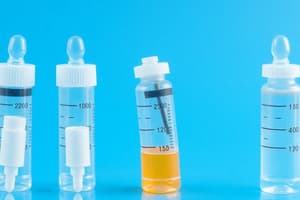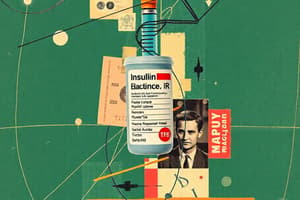Podcast
Questions and Answers
A patient with type 2 diabetes is prescribed insulin therapy. If the therapy is appropriately titrated, what approximate percentage range of A1c reduction can be expected?
A patient with type 2 diabetes is prescribed insulin therapy. If the therapy is appropriately titrated, what approximate percentage range of A1c reduction can be expected?
- 1 - 2% (correct)
- 3 - 4%
- 2 - 3%
- 0.5 - 1%
Which of the following ultra-rapid acting insulins is formulated with niacinamide to enhance its absorption rate?
Which of the following ultra-rapid acting insulins is formulated with niacinamide to enhance its absorption rate?
- Apidra
- Lyumjev
- NovoLog
- Fiasp (correct)
A patient requires rapid-acting insulin to manage postprandial glucose spikes. Which of the following insulins would be MOST appropriate?
A patient requires rapid-acting insulin to manage postprandial glucose spikes. Which of the following insulins would be MOST appropriate?
- Insulin lispro (correct)
- NPH insulin
- Insulin glargine
- Regular insulin
Which type of insulin is MOST likely to be prescribed for a patient who requires a concentrated form due to high insulin requirements?
Which type of insulin is MOST likely to be prescribed for a patient who requires a concentrated form due to high insulin requirements?
Which of the following insulin types has the LONGEST duration of action, offering flexible dosing due to its extended duration?
Which of the following insulin types has the LONGEST duration of action, offering flexible dosing due to its extended duration?
A patient is prescribed an insulin that provides stable basal insulin coverage with an onset around 1.5 hours and lasts approximately 24 hours. Which insulin is the patient MOST likely taking?
A patient is prescribed an insulin that provides stable basal insulin coverage with an onset around 1.5 hours and lasts approximately 24 hours. Which insulin is the patient MOST likely taking?
Which non-insulin antidiabetic agent is typically considered first-line therapy for type 2 diabetes due to its efficacy, weight neutrality, and low risk of hypoglycemia?
Which non-insulin antidiabetic agent is typically considered first-line therapy for type 2 diabetes due to its efficacy, weight neutrality, and low risk of hypoglycemia?
An overweight patient with type 2 diabetes is prescribed an antidiabetic medication that not only helps lower blood glucose but also offers cardiovascular and renal benefits. Which class of medication is MOST likely prescribed?
An overweight patient with type 2 diabetes is prescribed an antidiabetic medication that not only helps lower blood glucose but also offers cardiovascular and renal benefits. Which class of medication is MOST likely prescribed?
Which of the following antidiabetic medications uniquely targets both SGLT1 and SGLT2 receptors, leading to reduced renal glucose reabsorption and intestinal glucose absorption?
Which of the following antidiabetic medications uniquely targets both SGLT1 and SGLT2 receptors, leading to reduced renal glucose reabsorption and intestinal glucose absorption?
A patient with type 2 diabetes is prescribed a DPP-4 inhibitor. What is the PRIMARY mechanism of action of this class of drugs?
A patient with type 2 diabetes is prescribed a DPP-4 inhibitor. What is the PRIMARY mechanism of action of this class of drugs?
A patient with type 2 diabetes has a history of heart failure. Which DPP-4 inhibitor should be avoided, or used with caution, due to potential increased risk of heart failure?
A patient with type 2 diabetes has a history of heart failure. Which DPP-4 inhibitor should be avoided, or used with caution, due to potential increased risk of heart failure?
Which of the following mechanisms is NOT typically associated with GLP-1 receptor agonists (GLP-1 RAs)?
Which of the following mechanisms is NOT typically associated with GLP-1 receptor agonists (GLP-1 RAs)?
A patient with type 2 diabetes is prescribed liraglutide. What additional benefit, beyond glycemic control, makes this medication a favorable choice?
A patient with type 2 diabetes is prescribed liraglutide. What additional benefit, beyond glycemic control, makes this medication a favorable choice?
A patient is started on Tirzepatide for the management of their type 2 diabetes. What is the PRIMARY mechanism of action that differentiates Tirzepatide from other GLP-1 receptor agonists?
A patient is started on Tirzepatide for the management of their type 2 diabetes. What is the PRIMARY mechanism of action that differentiates Tirzepatide from other GLP-1 receptor agonists?
Which class of antidiabetic drugs is known to stimulate insulin release from pancreatic β-cells, but carries a risk of hypoglycemia and weight gain?
Which class of antidiabetic drugs is known to stimulate insulin release from pancreatic β-cells, but carries a risk of hypoglycemia and weight gain?
A patient with type 2 diabetes is prescribed pioglitazone. What is the MAIN mechanism by which this medication improves glycemic control?
A patient with type 2 diabetes is prescribed pioglitazone. What is the MAIN mechanism by which this medication improves glycemic control?
Which of the following is NOT a notable point regarding Metformin (Glucophage)?
Which of the following is NOT a notable point regarding Metformin (Glucophage)?
Which class of medications has demonstrated cardiovascular and renal benefits in clinical trials?
Which class of medications has demonstrated cardiovascular and renal benefits in clinical trials?
Which of the following statements BEST describes the action of Afrezza?
Which of the following statements BEST describes the action of Afrezza?
Which factor differentiates Tresiba from Lantus?
Which factor differentiates Tresiba from Lantus?
Which insulin is MOST appropriate for basal coverage and exhibits a peak and shorter duration than long-acting insulins?
Which insulin is MOST appropriate for basal coverage and exhibits a peak and shorter duration than long-acting insulins?
Which of the following drugs does NOT belong to the SGLT2 inhibitor class?
Which of the following drugs does NOT belong to the SGLT2 inhibitor class?
A patient is prescribed Exenatide (Byetta). Which of the following side effects is MOST commonly associated with this medication:
A patient is prescribed Exenatide (Byetta). Which of the following side effects is MOST commonly associated with this medication:
Which medication is available in both injectable and oral formulations?
Which medication is available in both injectable and oral formulations?
What is the generic name for Admelog?
What is the generic name for Admelog?
A patient who recently started on Pioglitazone reports swelling in their ankles. Which side effect is MOST likely?
A patient who recently started on Pioglitazone reports swelling in their ankles. Which side effect is MOST likely?
Which of the following insulin preparations is the MOST rapid-acting?
Which of the following insulin preparations is the MOST rapid-acting?
Which of the following insulins is MOST appropriate to administer prior to a meal in order to cover the expected rise in blood glucose?
Which of the following insulins is MOST appropriate to administer prior to a meal in order to cover the expected rise in blood glucose?
Which of the following non-insulin antidiabetic medications carries the HIGHEST risk of causing hypoglycemia as a side effect?
Which of the following non-insulin antidiabetic medications carries the HIGHEST risk of causing hypoglycemia as a side effect?
According to the information provided, overall, appropriately titrated insulin therapy can reduce A1c by approximately:
According to the information provided, overall, appropriately titrated insulin therapy can reduce A1c by approximately:
A patient with type 2 diabetes is on Metformin but still requires additional glycemic control. Which of the following medications would be MOST appropriate to add, considering the patient's history of cardiovascular disease?
A patient with type 2 diabetes is on Metformin but still requires additional glycemic control. Which of the following medications would be MOST appropriate to add, considering the patient's history of cardiovascular disease?
A patient asks about the primary difference between Humalog and NovoLog. What is the MOST accurate comparison?
A patient asks about the primary difference between Humalog and NovoLog. What is the MOST accurate comparison?
A patient taking insulin reports experiencing hypoglycemia more frequently at night. If their insulin regimen includes NPH insulin, what would be the MOST likely cause?
A patient taking insulin reports experiencing hypoglycemia more frequently at night. If their insulin regimen includes NPH insulin, what would be the MOST likely cause?
A patient is interested in an oral medication that has a lower risk of hypoglycemia than sulfonylureas. Which of the following is the MOST appropriate choice?
A patient is interested in an oral medication that has a lower risk of hypoglycemia than sulfonylureas. Which of the following is the MOST appropriate choice?
How does the mechanism of action of SGLT2 inhibitors differ from that of Metformin in managing type 2 diabetes?
How does the mechanism of action of SGLT2 inhibitors differ from that of Metformin in managing type 2 diabetes?
Which of the following drugs improves insulin sensitivity in adipose tissue, muscle, and liver?
Which of the following drugs improves insulin sensitivity in adipose tissue, muscle, and liver?
A patient newly diagnosed with type 2 diabetes is prescribed Metformin. What is the typical A1c reduction expected with Metformin?
A patient newly diagnosed with type 2 diabetes is prescribed Metformin. What is the typical A1c reduction expected with Metformin?
A patient is prescribed Afrezza to manage post-meal blood glucose levels. Which of the following administration instructions is MOST important for the patient to know?
A patient is prescribed Afrezza to manage post-meal blood glucose levels. Which of the following administration instructions is MOST important for the patient to know?
A patient is prescribed Fiasp for mealtime coverage. What is the MOST important counseling point regarding its administration?
A patient is prescribed Fiasp for mealtime coverage. What is the MOST important counseling point regarding its administration?
Which of the following BEST describes the distinguishing feature of Lyumjev compared to other rapid-acting insulins?
Which of the following BEST describes the distinguishing feature of Lyumjev compared to other rapid-acting insulins?
A patient using Humalog consistently experiences postprandial hyperglycemia. What adjustment to their insulin regimen is MOST appropriate?
A patient using Humalog consistently experiences postprandial hyperglycemia. What adjustment to their insulin regimen is MOST appropriate?
A patient is starting on NovoLog. What is the MOST important instruction to provide regarding when to take this medication?
A patient is starting on NovoLog. What is the MOST important instruction to provide regarding when to take this medication?
What is the MOST appropriate timing for administering Apidra relative to meals?
What is the MOST appropriate timing for administering Apidra relative to meals?
Which consideration is MOST critical when switching a patient from Humulin R U-100 to Humulin R U-500?
Which consideration is MOST critical when switching a patient from Humulin R U-100 to Humulin R U-500?
When should Afrezza be administered in relation to meals?
When should Afrezza be administered in relation to meals?
What is the PRIMARY reason Humulin R U-500 is prescribed over standard U-100 insulin?
What is the PRIMARY reason Humulin R U-500 is prescribed over standard U-100 insulin?
A patient on Humulin N is experiencing early morning hyperglycemia. What is the MOST likely cause?
A patient on Humulin N is experiencing early morning hyperglycemia. What is the MOST likely cause?
What is a key counseling point for patients who are prescribed Humulin N?
What is a key counseling point for patients who are prescribed Humulin N?
What is the PRIMARY advantage of Lantus (insulin glargine) over NPH insulin for basal coverage?
What is the PRIMARY advantage of Lantus (insulin glargine) over NPH insulin for basal coverage?
A patient on Lantus reports experiencing fasting hyperglycemia despite consistent dosing. What should be considered?
A patient on Lantus reports experiencing fasting hyperglycemia despite consistent dosing. What should be considered?
What is the MOST significant advantage of Toujeo over other long-acting insulin preparations?
What is the MOST significant advantage of Toujeo over other long-acting insulin preparations?
A patient on Tresiba is traveling internationally and will be shifting time zones. What advice should they receive regarding their insulin dosing?
A patient on Tresiba is traveling internationally and will be shifting time zones. What advice should they receive regarding their insulin dosing?
What is the PRIMARY mechanism of action of Metformin?
What is the PRIMARY mechanism of action of Metformin?
A patient newly diagnosed with type 2 diabetes also has stage 3 chronic kidney disease. Which factor is MOST important when considering metformin?
A patient newly diagnosed with type 2 diabetes also has stage 3 chronic kidney disease. Which factor is MOST important when considering metformin?
Which of the following is MOST accurate regarding the expected A1c reduction with Metformin?
Which of the following is MOST accurate regarding the expected A1c reduction with Metformin?
A patient with type 2 diabetes is prescribed Fiasp. Which of the following is the MOST important counseling point regarding its mechanism of action:
A patient with type 2 diabetes is prescribed Fiasp. Which of the following is the MOST important counseling point regarding its mechanism of action:
A patient with type 2 diabetes is prescribed Lyumjev. Which of the following is the MOST important counseling point?
A patient with type 2 diabetes is prescribed Lyumjev. Which of the following is the MOST important counseling point?
A patient using Humalog consistently experiences postprandial hyperglycemia. What is the MOST likely reason for this? (Select the BEST option)
A patient using Humalog consistently experiences postprandial hyperglycemia. What is the MOST likely reason for this? (Select the BEST option)
A patient is prescribed NovoLog for their type 2 diabetes. Which of the following is the appropriate timing of medication administration?
A patient is prescribed NovoLog for their type 2 diabetes. Which of the following is the appropriate timing of medication administration?
A patient with type 2 diabetes is prescribed Humulin R U-100 / Novolin R U-100. Which of the following is MOST important regarding timing?
A patient with type 2 diabetes is prescribed Humulin R U-100 / Novolin R U-100. Which of the following is MOST important regarding timing?
A patient with a history of chronic obstructive pulmonary disease (COPD) and type 2 diabetes requires mealtime insulin. What is the BEST option?
A patient with a history of chronic obstructive pulmonary disease (COPD) and type 2 diabetes requires mealtime insulin. What is the BEST option?
A patient with extreme insulin resistance requires high doses of insulin. What is the best insulin?
A patient with extreme insulin resistance requires high doses of insulin. What is the best insulin?
What would be the MOST accurate counseling point with Lantus?
What would be the MOST accurate counseling point with Lantus?
Which of the following is an example of a Long-Acting Insulin?
Which of the following is an example of a Long-Acting Insulin?
What is the MOST accurate mechanism of action of Metformin?
What is the MOST accurate mechanism of action of Metformin?
A patient is prescribed Humulin R U-500. What is the MOST important risk of this prescription?
A patient is prescribed Humulin R U-500. What is the MOST important risk of this prescription?
A patient is experiencing nocturnal hypoglycemia on Humulin N. What risk is this associated with?
A patient is experiencing nocturnal hypoglycemia on Humulin N. What risk is this associated with?
What is MOST likely to be important regarding the long duration of Toujeo?
What is MOST likely to be important regarding the long duration of Toujeo?
What is the most appropriate instruction regarding Afrezza?
What is the most appropriate instruction regarding Afrezza?
Who is most likely NOT a candidate for Afrezza?
Who is most likely NOT a candidate for Afrezza?
What is the most accurate duration of time to expect with Tresiba?
What is the most accurate duration of time to expect with Tresiba?
What is the BEST counseling point for Tresiba?
What is the BEST counseling point for Tresiba?
Why is knowing the onset of insulins important for patients?
Why is knowing the onset of insulins important for patients?
What is the BEST description of Humulin N?
What is the BEST description of Humulin N?
What is the BEST description of Humulin R U-500?
What is the BEST description of Humulin R U-500?
A1c can be lowered by how much with proper insulin titration?
A1c can be lowered by how much with proper insulin titration?
A patient on Tresiba wants to change the time they take the medication. Select the correct response:
A patient on Tresiba wants to change the time they take the medication. Select the correct response:
A patient is started on Metformin. What is essential to discuss with this patient?
A patient is started on Metformin. What is essential to discuss with this patient?
Flashcards
Fiasp Mechanism
Fiasp Mechanism
Insulin aspart, formulated with niacinamide for faster absorption, acts rapidly at mealtimes.
Lyumjev Mechanism
Lyumjev Mechanism
Rapid-acting formulation with accelerated absorption for mealtime control.
Admelog and Humalog Mechanism
Admelog and Humalog Mechanism
Rapid onset to cover mealtime glucose spikes.
NovoLog Mechanism
NovoLog Mechanism
Signup and view all the flashcards
Apidra Mechanism
Apidra Mechanism
Signup and view all the flashcards
Humulin R U-100 and Novolin R U-100 Mechanism
Humulin R U-100 and Novolin R U-100 Mechanism
Signup and view all the flashcards
Afrezza (inhaled) Mechanism
Afrezza (inhaled) Mechanism
Signup and view all the flashcards
Humulin R U-500 Mechanism
Humulin R U-500 Mechanism
Signup and view all the flashcards
Humulin N and Novolin N Mechanism
Humulin N and Novolin N Mechanism
Signup and view all the flashcards
Lantus, Basaglar, Semglee, Rezvoglar Mechanism
Lantus, Basaglar, Semglee, Rezvoglar Mechanism
Signup and view all the flashcards
Toujeo Mechanism
Toujeo Mechanism
Signup and view all the flashcards
Tresiba Mechanism
Tresiba Mechanism
Signup and view all the flashcards
Metformin (Glucophage) Mechanism
Metformin (Glucophage) Mechanism
Signup and view all the flashcards
Canagliflozin, Dapagliflozin, Empagliflozin, Ertugliflozin Mechanism
Canagliflozin, Dapagliflozin, Empagliflozin, Ertugliflozin Mechanism
Signup and view all the flashcards
Sotagliflozin (Zynquista) Mechanism
Sotagliflozin (Zynquista) Mechanism
Signup and view all the flashcards
Sitagliptin, Saxagliptin, Linagliptin, Alogliptin Mechanism
Sitagliptin, Saxagliptin, Linagliptin, Alogliptin Mechanism
Signup and view all the flashcards
Exenatide (Byetta and Bydureon) MOA
Exenatide (Byetta and Bydureon) MOA
Signup and view all the flashcards
Liraglutide (Victoza) Mechanism
Liraglutide (Victoza) Mechanism
Signup and view all the flashcards
Dulaglutide (Trulicity) Mechanism
Dulaglutide (Trulicity) Mechanism
Signup and view all the flashcards
Semaglutide (Ozempic and Rybelsus) MOA
Semaglutide (Ozempic and Rybelsus) MOA
Signup and view all the flashcards
Lixisenatide (Adlyxin) Mechanism
Lixisenatide (Adlyxin) Mechanism
Signup and view all the flashcards
Tirzepatide (Mounjaro) Mechanism
Tirzepatide (Mounjaro) Mechanism
Signup and view all the flashcards
Glipizide, Glyburide, Glimepiride Mechanism
Glipizide, Glyburide, Glimepiride Mechanism
Signup and view all the flashcards
Pioglitazone Mechanism
Pioglitazone Mechanism
Signup and view all the flashcards
Fiasp
Fiasp
Signup and view all the flashcards
Common Insulin Risks
Common Insulin Risks
Signup and view all the flashcards
Lyumjev
Lyumjev
Signup and view all the flashcards
NovoLog Timing
NovoLog Timing
Signup and view all the flashcards
Apidra timing
Apidra timing
Signup and view all the flashcards
Humulin R/Novolin R Timing
Humulin R/Novolin R Timing
Signup and view all the flashcards
Afrezza Contraindications
Afrezza Contraindications
Signup and view all the flashcards
Humulin R U-500 Risks
Humulin R U-500 Risks
Signup and view all the flashcards
NPH Insulin considerations
NPH Insulin considerations
Signup and view all the flashcards
Insulin Glargine Duration
Insulin Glargine Duration
Signup and view all the flashcards
Toujeo Dosing
Toujeo Dosing
Signup and view all the flashcards
Tresiba flexibility
Tresiba flexibility
Signup and view all the flashcards
Study Notes
- Insulin therapy, when properly adjusted, can lower A1c by about 1–2%.
- Insulin is used to replace or supplement endogenous insulin.
- Insulin regimens (basal, bolus, or basal‑bolus), when titrated properly, may reduce A1c by roughly 1–2% or more depending on baseline hyperglycemia.
- Hypoglycemia, weight gain, and injection site reactions are common risks of insulin therapy.
Ultra‑Rapid Acting Insulins
- Act quickly at meal times.
- Used as part of an intensive insulin regimen, typically contributes to a ~1–2% reduction when combined with basal insulin.
- Fiasp and Lyumjev are both used at meal times.
- Both Fiasp and Lyumjev contribute to an overall ~1–2% reduction when used in combination therapy.
- Fiasp (Insulin aspart): formulated with niacinamide for faster absorption.
- Contraindicated in patients with known hypersensitivity to insulin aspart or its excipients.
- Use cautiously in patients at risk for hypoglycemia.
- Onset 5–10 minutes, duration 3–5 hours.
- Injected subcutaneously near meal time.
- Lyumjev (Insulin lispro‐aabc): rapid-acting formulation with accelerated absorption for mealtime control.
- Avoid in patients with allergy to lispro or formulation components.
- Monitor closely to minimize hypoglycemia.
- Onset ~15 minutes; duration ~3–5 hours.
Rapid-Acting Insulins
- Used to cover mealtime glucose spikes integrated in basal-bolus regimens, contributing to an overall reduction of ~1–2%.
- Admelog and Humalog, NovoLog, and Apidra all contribute to an overall ~1–2% reduction when used in basal-bolus regimens.
- Admelog and Humalog (Insulin lispro): rapid onset to cover mealtime glucose spikes.
- Contraindicated in patients with known hypersensitivity.
- Caution in patients with erratic meal patterns or renal impairment due to hypoglycemia risk.
- Onset 15–30 minutes, duration 3–5 hours.
- Administer 15 minutes before or immediately after meals.
- NovoLog (Insulin aspart): quick onset and short duration to match postprandial needs.
- Watch for hypoglycemia.
- Onset 10–20 minutes, duration ~3–5 hours.
- Injection 5–10 minutes before a meal is typical.
- Apidra (Insulin glulisine): for meal coverage.
- Contraindicated in patients with hypersensitivity to insulin glulisine.
- Hypoglycemia is a risk if dosing/timing is not optimal.
- Onset ~20 minutes; duration ~3–5 hours.
- Administer within 15 minutes before or 20 minutes after a meal.
Short-Acting (Regular) Insulins
- Used preprandially, integrated into therapy, contribute to an overall reduction of ~1–2%.
- Humulin R U‑100, Novolin R U‑100 and Afrezza contribute to overall ~1–2% A1c reduction.
- Humulin R U‑100 and Novolin R U‑100 (Regular insulin): Slightly slower onset than rapid-acting insulins.
- Contraindicated in patients with hypersensitivity to regular insulin.
- Increased risk of hypoglycemia if timing or dosing is off.
- Onset ~30 minutes; duration ~8 hours.
- Typically injected 30 minutes prior to meals.
- Afrezza (inhaled regular insulin): Provides a rapid, non‑injection option for mealtime insulin delivery.
- Contraindicated in patients with chronic lung disease (e.g., asthma, COPD) or smokers.
- Monitor lung function.
- Onset 12–20 minutes; duration ~2.5–3 hours.
- Inhalation is performed at the beginning of a meal.
- Humulin R U‑500 (Concentrated regular insulin (500 U/mL)): prolonged duration; used for patients with high insulin requirements.
- Increased risk for dosing errors and prolonged hypoglycemia if not managed carefully.
- Contraindicated in patients with known hypersensitivity.
- Onset ~30 minutes; duration mean ~21 hours (range 13–24 hours).
- Requires careful monitoring of blood glucose to prevent insulin stacking.
Intermediate-Acting Insulins
- Exhibits a peak and shorter duration than long‑acting insulins, contributes as part of a basal regimen to achieve a ~1–2% reduction overall.
- Humulin N and Novolin N (NPH insulin): Provides basal coverage
- Contraindicated in patients with known hypersensitivity to NPH insulin.
- Risk of nocturnal hypoglycemia due to the peak effect.
- Onset ~1.5 hours; duration 12–24 hours.
- Often requires twice-daily dosing to maintain 24‑hour coverage.
Long-Acting Insulins
- Typically used once daily as the basal component in a regimen that can lower A1c by ~1–2%.
- Lantus, Basaglar, Semglee, Rezvoglar (Insulin glargine): peakless, stable basal insulin coverage with an onset around 1.5 hours and ~24‑hour duration.
- Contraindicated in patients with hypersensitivity to insulin glargine.
- Overdosage may cause prolonged hypoglycemia.
- Onset ~1.5 hours; duration ~24 hours (may be used once daily, although some patients might benefit from twice-daily dosing).
Ultra-Long Acting Insulins
- Part of a regimen targeting overall glycemic control with a similar 1–2% reduction potential.
- Toujeo (Insulin glargine): Extended duration (24–36 hours) allows for a more stable basal level.
- Contraindicated in patients with hypersensitivity.
- Monitor for hypoglycemia, especially during transitions.
- Onset ~1 hour; duration 24–36 hours.
- Allows for flexible dosing times.
- Tresiba (Insulin degludec): duration of 36–42 hours offering flexible dosing.
- Contraindicated in individuals with known hypersensitivity.
- Like all insulins, careful monitoring to avoid hypoglycemia is essential.
- Onset ~1.5 hours; duration 36–42 hours.
- Offers dosing flexibility (different times of day).
Non‑Insulin Antidiabetic Agents
Biguanides
- Metformin (Glucophage): Inhibits hepatic gluconeogenesis, enhances insulin sensitivity, and improves peripheral glucose uptake, reduces A1c by about 1–2%.
- First‑line therapy in type 2 diabetes; weight-neutral or modest weight loss; low risk of hypoglycemia.
- Contraindicated in patients with severe renal impairment (e.g., eGFR
Studying That Suits You
Use AI to generate personalized quizzes and flashcards to suit your learning preferences.




